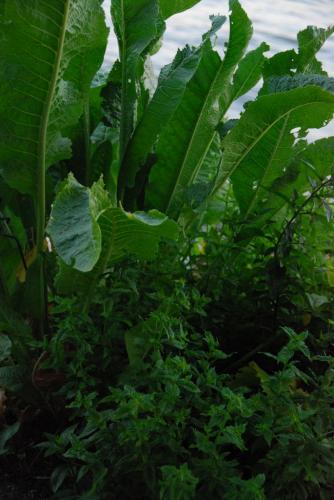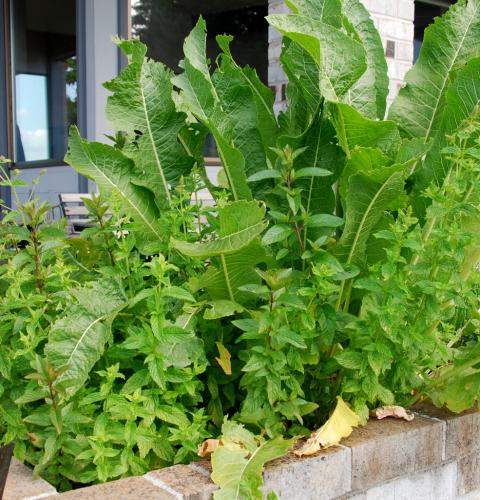|
Recent Entries to this Blog
ADVENTures for the Holidays.
Posted: 27 Nov 2011 Posted: 09 Sep 2011 Posted: 02 Sep 2011 Posted: 29 Aug 2011 Posted: 13 Aug 2011 All Entries |
Karrma's Blog
Bay Leaves, Shakespeare and Serendipity
Category: Herbs | Posted: Fri Sep 09, 2011 10:11 pm Two Bays or Not Two Bays, That is the Question Whether 'tis Nobilis......Laurel nobilis only, or whether California Bay Laurel is also a safe herb. For two years, I searched the nurseries for a healthy Bay Laurel plant, and had to purchase dried Bay Leaf at the grocery. "Spice Island" which I thought was a good brand, was selling the California Bay leaf as Bay Leaf. I had read somewhere that California Bay was toxic, and so I finally am looking into this question. The real question is how much coumarin is safe. And I "opened a can of worms" when I started looking into it. The German government even got into this debate a few years ago. Coumarin is a chemical in some plants, that can have some medical benefit, but is toxic in higher doses. Bay Laurel is sweet and does not have coumarins such as umbelliferone. California Bay Laurel or Myrtle, Umbellularia californica, does. In too high of doses, it is bad for rat livers and us. Similarly the German government tested some Christmas cinnamon cookies, and found such a high level of coumarin in some cookies, that it could have harmed a child or small adult that overindulged. The government initially tried to ban the cookies, then just recommended people not each much. http://www.npr.org/templates/story/story.php?storyId=6672644 Anyone heard about true cinnamon versus "not true" cinnamon? I had assumed, wrongly, that it was just not as flavorful. The important difference is they have different amounts of coumarins. The Ceylon (Sri Lanka, Serendip) cinnamon, or Cinnamomum verum, and Indonesian cinnamon, or C. burmannii do not have coumarin in them and are safe in any quantity. C. cassia or Chinese cinnamon, does have high levels and can reach toxic cookie levels. I remember hearing that chamomile is not safe for pregnant women, and the reason is: coumarins. Low levels of coumarin, thought to be safe in general when used for teas or flavoring wines, are chamomile, sweet woodruff, and sweet grass. They can, however, cause a worse headache than the wine alone per one citation. Clover is considered toxic due to coumarins, and one of the clover fungus can convert this into a blood thinner, causing Sweet Clover disease in cows, as well as the discovery of Coumadin to prevent blood clots. So, my personal answer to this question is 'tis Nobilis. I have posted information, so people can decide their own levels of comfort. I finally, after two years, found another healthy Bay Laurel Tree, and am trying to be very careful it does not get infected. (My last one got some sort of leaf sucking bug on it, that I just could not get rid of with washing the leaves, and it slowly dwindled away.) I am also going to be very persnickety about my cinnamon. Since I don't like chamomile, I have no problem with avoiding it. My sweet woodruff did get into one bottle of wine, but is looking better as a groundcover. No wonder I planted it in my flower garden rather than my herb garden. That is serendipity. To be or not to be, that is the question. Whether 'tis nobler in the mind to suffer The slings and arrows of outrageous fortune, Or to take arms against a sea of troubles, And by opposing end them? Last edited: Fri Sep 09, 2011 10:24 pm This blog entry has been viewed 596 times
How to Kill Mint, or My First Attempt at an Herb Garden
Category: Herbs | Posted: Fri Sep 02, 2011 5:59 am I did know a little bit about mint before I started growing it. I knew that it was in my toothpaste, gum and in thin mints. I knew that it was in Mint Juleps, which sounded so romantic. But I did not know anybody could be such a bad gardener that they could kill it off without trying. Every article about mint comes with a warning, "This spreads faster than a rumor about that crazy Karrma lady," or something to that effect. So I dutifully put it in half a wine barrel to contain it, and ignored it. It grew like mad, and I was able to harvest some for my first Mint Julep, which I think was my last. It died back in the winter, and grew some more in the summers. But after a while, about 3-4 years of total neglect other than harvesting some branches for tea or chocolate anything, the beautiful mint spears would only be at the very rim of the barrel, and nothing grew in the center, not even a weed. Not even enough for me. Fertilizer did not help. Water did not help, Pinching it back did help get a few more branches, but no new stems. Why was the dirt just sitting there? So one day the barrel fell apart, so I was able to examine the results of my benign neglect: a perfect cast of the barrel in mint root cement. It appeared that even mint can get so root bound there is no room for water or dirt. So I learned: 1. Mint spears will grow from any part of a root that is cut or broken. (I never broke or cut the root, so it only grew at the rim of the barrel) 2. The more you cut or tear at the roots, the happier the plant and root will be and the faster it grows. 3. You still need to plant mint in a closed container. So now I have my spearmint growing betwixt my peppermint, and bordered by the only other plant that can battle the mint growth, horseradish. Every fall, the mint gets topped after the flowering. Leaves remain for a few more months, then die back. Every spring, this corner gets dug up and abused, indiscriminately hacking away at any roots that are not fresh and plump, pulling out about 2/3 of the roots where I want it to grow. Then I very gently and carefully pull back any root streamers that are trying to escape. So the paradox of mint, the more you hack away at it, the better it grows. Now I just need to find a better Mint Julep recipe. 
Spearmint, Peppermint, Horseradish ( photo / image / picture from Karrma's Garden ) 
Spearmint, Peppermint, Horseradish ( photo / image / picture from Karrma's Garden ) This blog entry has been viewed 753 times
You're reading one of many blogs on GardenStew.com.
Register for free and start your own blog today. |
|
